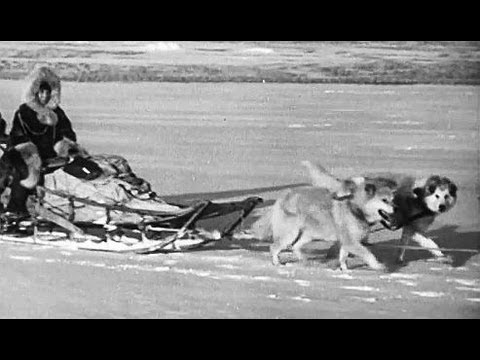more at
First person narrative describing the lives of Eskimos on the coast of Alaska.
NEW VERSION with improved video & sound:
Public domain film from the National Archives, slightly cropped to remove uneven edges, with the aspect ratio corrected, and mild video noise reduction applied.
The soundtrack was also processed with volume normalization, noise reduction, clipping reduction, and/or equalization (the resulting sound, though not perfect, is far less noisy than the original).
Eskimos (or Esquimaux) or Inuit–Yupik (for Alaska: Inupiat–Yupik) peoples are indigenous peoples who have traditionally inhabited the circumpolar region from eastern Siberia (Russia), across Alaska (United States), Canada, and Greenland.
There are two main groups that are referred to as Eskimo: Yupik and Inuit. A third group, the Aleut, is related. The Yupik language dialects and cultures in Alaska and eastern Siberia have evolved in place beginning with the original (pre-Dorset) Eskimo culture that developed in Alaska. Approximately 4,000 years ago the Unangan (also known as Aleut) culture became distinctly separate, and evolved into a non-Eskimo culture. Approximately 1,500–2,000 years ago, apparently in Northwestern Alaska, two other distinct variations appeared. The Inuit language branch became distinct and in only several hundred years spread across northern Alaska, Canada and into Greenland. At about the same time, the technology of the Thule people developed in northwestern Alaska and very quickly spread over the entire area occupied by Eskimo people, though it was not necessarily adopted by all of them.
The earliest known Eskimo cultures (pre-Dorset) date to 5,000 years ago. They appear to have evolved in Alaska from people using the Arctic small tool tradition who probably had migrated to Alaska from Siberia at least 2,000 to 3,000 years earlier, though they might have been in Alaska as far back as 10,000 to 12,000 years or more. There are similar artifacts found in Siberia going back perhaps 18,000 years.
Today, the two main groups of Eskimos are the Inuit of northern Alaska, Canada and Greenland, and the Yupik of Central Alaska. The Yupik comprises speakers of four distinct Yupik languages originated from the western Alaska, in South Central Alaska along the Gulf of Alaska coast, and the Russian Far East.
The term Eskimo is commonly used by those in the lower 48 and in Alaska to include both Yupik and Inupiat…
Point Hope (Inupiaq Tikiġaq) is a city in North Slope Borough, Alaska, United States. At the 2010 census the population was 674.
Point Hope town is located in the Point Hope landhead, at the NW end of the Lisburne Peninsula, on the Chukchi Sea coast, 40 mi. SW of Cape Lisburne, Arctic Slope at 68°20′49″N 166°45′47″W…
Before any modern settlement, the Ipiutak lived here.
The descriptive Inuit name of the place, “Tikarakh” or “Tikigaq” commonly spelled “Tiagara”, means “forefinger”. It was recorded as “Tiekagagmiut” in 1861 by P. Tikhmeniev Wich of the Russian Hydrographic Department and on Russian Chart 1495 it became “Tiekaga”. This ancient village site was advantageous, because the protrusion of Point Hope into the sea brought the whales close to the shore. At Tikigaq, they built semi-subterranean houses using mainly whalebone and driftwood. Point Hope is one of the oldest continually occupied sites in North America. While some of the earlier dwellings have been lost to erosion as the island shrinks, it still provides a welter of valuable information to archaeologists on how early Eskimos survived in their harsh environment. The Tikigaq site is “by far the most extensive and complete one-period site yet discovered and described in the entire circumpolar region.” – Helge Larsen.
The first recorded Europeans to sight this cape were Russian explorers Mikhail Vasiliev and Gleb Shishmaryov of the Imperial Russian Navy on the ships Otkrietie and Blagonamierennie. Vasiliev and Shishmaryov named this landhead Mys Golovnina, after Vice Admiral Vasily Golovnin (1776–1831).
The cape at Point Hope was renamed by Captain Frederick William Beechey of the Royal Navy, who wrote on August 2, 1826: “I named it Point Hope in compliment to Sir William Johnstone Hope”. According to Archdeacon Stuck Hope was from a “well-known house long connected with the sea”.
Point Hope residents successfully opposed Operation Chariot (1958), which would have involved buried thermonuclear detonations some 30 miles from the village to create a deep-water artificial harbor, which would only have been usable about three months out of the year…

